In biology, setae are any of a number of different bristle- or hair-like structures on living organisms.

This glossary of entomology describes terms used in the formal study of insect species by entomologists.

The Agromyzidae are a family of flies, commonly referred to as the leaf-miner flies for the feeding habits of their larvae, most of which are leaf miners on various plants. It includes roughly 2,500 species, they are small, some with wing length of 1 mm. The maximum size is 6.5 mm. Most species are in the range of 2 to 3 mm.

Lucilia mexicana is a species of blow fly of the family Calliphoridae, one of many species known as a green bottle fly. Its habitat range extends from southwestern North America to Brazil. L. mexicana is typically 6–9 mm in length with metallic blue-green coloring. This species is very similar in appearance to L. coeruleiviridis, the primary difference being that L. mexicana has two or more complete rows of post-ocular setae. L. mexicana has the potential to be forensically important in the stored-products and medicocriminal fields, but more research is needed for the fly to be used as evidence in criminal investigations.

Hydrotaea dentipes is a fly from the family Muscidae. Its larvae have been found in the dung of rabbits, pigs, cows, horses, chickens and humans. It is found in the Palearctic.
This glossary describes the terms used in formal descriptions of spiders; where applicable these terms are used in describing other arachnids.
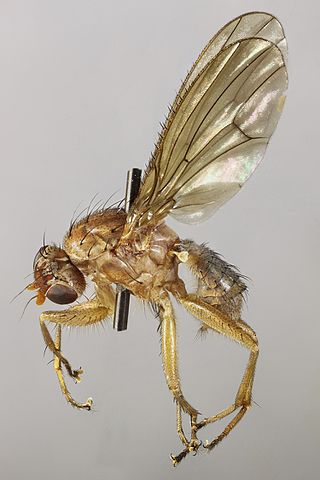
Suillia bicolor is a Palearctic species of Heleomyzidae. The sctellum is covered with light, fine, scattered hairs. The wing venation is characterized by the presence of small spines on the costal vein. The first pair of legs of the male has the first tarsal segments equipped with a spike of a triangular shape and a width smaller than the width of the segment. The female's abdomen has a seventh segment that is longer than the sixth. The reproductive organs of females have three irregularly jagged, cylindrical in outline, seminal receptacles narrowly curled at the apex. For terms see Morphology of Diptera.
Dipteran morphology differs in some significant ways from the broader morphology of insects. The Diptera is a very large and diverse order of mostly small to medium-sized insects. They have prominent compound eyes on a mobile head, and one pair of functional, membraneous wings, which are attached to a complex mesothorax. The second pair of wings, on the metathorax, are reduced to halteres. The order's fundamental peculiarity is its remarkable specialization in terms of wing shape and the morpho-anatomical adaptation of the thorax – features which lend particular agility to its flying forms. The filiform, stylate or aristate antennae correlate with the Nematocera, Brachycera and Cyclorrhapha taxa respectively. It displays substantial morphological uniformity in lower taxa, especially at the level of genus or species. The configuration of integumental bristles is of fundamental importance in their taxonomy, as is wing venation. It displays a complete metamorphosis, or holometabolous development. The larvae are legless, and have head capsules with mandibulate mouthparts in the Nematocera. The larvae of "higher flies" (Brachycera) are however headless and wormlike, and display only three instars. Pupae are obtect in the Nematocera, or coarcate in Brachycera.

Zigrasimecia is an extinct genus of ants which existed in the Cretaceous period approximately 98 million years ago. The first specimens were collected from Burmese amber in Kachin State, 100 kilometres (62 mi) west of Myitkyina town in Myanmar. In 2013, palaeoentomologists Phillip Barden and David Grimaldi published a paper describing and naming Zigrasimecia tonsora. They described a dealate female with unusual features, notably the highly specialized mandibles. Other features include large ocelli, short scapes, 12 antennomeres, small eyes, and a clypeal margin that has a row of peg-like denticles. The genus Zigrasimecia was originally incertae sedis within Formicidae until a second species, Zigrasimecia ferox, was described in 2014, leading to its placement in the subfamily Sphecomyrminae. Later, it was considered to belong to the distinct subfamily Zigrasimeciinae.

Xylota tarda is a Palearctic species of hoverfly.
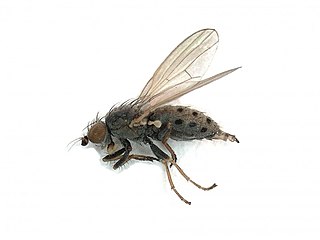
Chamaemyia flavipalpis is a species of fly in the family Chamaemyiidae. It is found in the Palearctic. and North Africa.

Morpholeria ruficornis is a species of fly in the family Heleomyzidae. It is found in the Palearctic.
Gymnochiromyia flavella is a species of fly in the family Chyromyidae. It is found in the Palearctic.

Elgiva cucularia is a species of fly in the family Sciomyzidae. It is found in the Palearctic. Long. : 5–8 mm.Overall it is coloured yellowish-brown with a bluish-gray body. The head is characterized by silky black dots at the bases of the anterior orbital setae, between the bases of the antennae and the edges of the compound eyes, and in the centre of the occiput. The third antenna segment is a little shorter than the second. The mesonotum is black with a grey ground and grey pruinosity.There are longitudinal, brown stripes on the dorsum of the thorax: two narrow in the middle and two wide on the sides. One mesopleural bristle amongst short setae.The prothorax is bare. The yellowish smoky wings are 5.2 to 6.8 mm long and have fuzzy spots on the front half. The legs and abdomen are yellow. The lower surfaces of the hind femora are equipped with setae, while the front pair lacks them.The abdomen is rufous.For terms see Morphology of Diptera. Larvae of E. cucularia are predators of aquatic, pulmonate snails in the families Lymnaeidae, Physidae, and Planorbidae.

Heleomyza serrata is a species of fly in the family Heleomyzidae. It is found in the Palearctic.
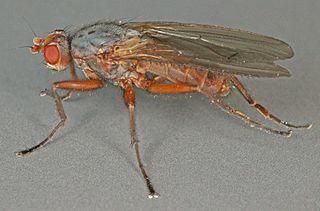
Scoliocentra villosa is a species of fly in the family Heleomyzidae. It is found in the Palearctic . This species was described in 1830 by Johann Wilhelm Meigen as Helomyza villosa [1].

Heteromyza rotundicornis is a species of fly in the family Heleomyzidae. It is found in the Palearctic.
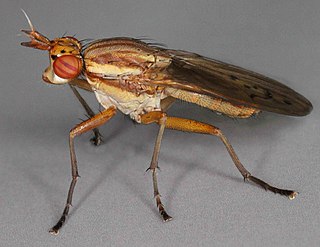
Ilione albiseta is a species of fly in the family Sciomyzidae. It is found in the Palearctic. The body length is 8 to 11.2mm and the basic colour is yellowish-brown. The spot on the occiput, the spots at the base of the frontal orbital setae and the almost triangular spots at the edge of the eyes at the height of the antennae are silky dark brown. The long antennae have a whitish hairy arists. There are longitudinal, brown stripes on the yellowish-dustedmesonotum : two narrow in the middle and two wide on the sides. In addition, there is a brown band on the body below the notopleura. The prosternum is bare. Chaetotaxy of the thorax shows strong presutural acrostichal setae and 2–3 well-developed subalar setae. The wings are 6.8 to 8 mm long and usually have 5 marks: on the anterior transverse vein, the medial vein, and the two ends of the posterior transverse vein. If there are only 2 dots on the medial vein, the transverse veins are at least darkened. The legs are yellow with darkened tarsi. The lower surfaces of the femora of the hind legs are equipped with strong and dense setae in males, and with short and sparse setae in females. Males are characterized by a copulatory apparatus with non-swollen abdominal pituitary glands.For terms see Morphology of Diptera. The larva preys on Galba truncatula
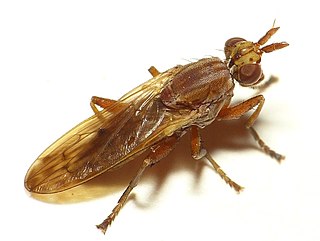
Elgiva solicita is a species of fly in the family Sciomyzidae. It is found in the Palearctic
Cheilosia longula is a Palearctic hoverfly.















